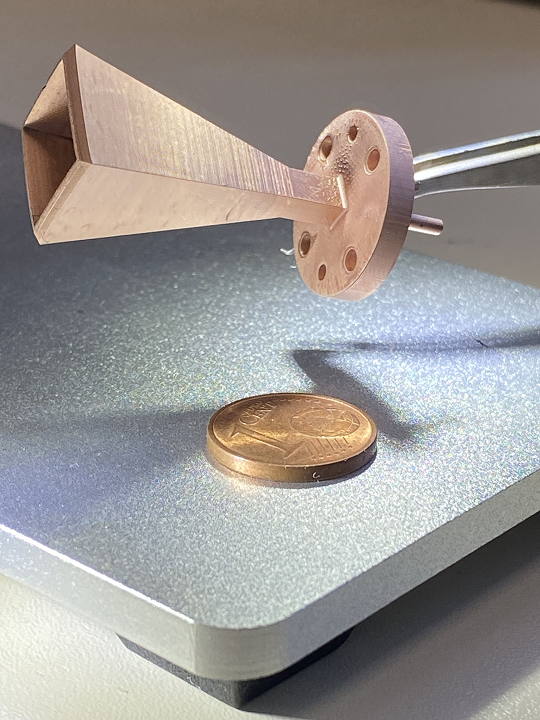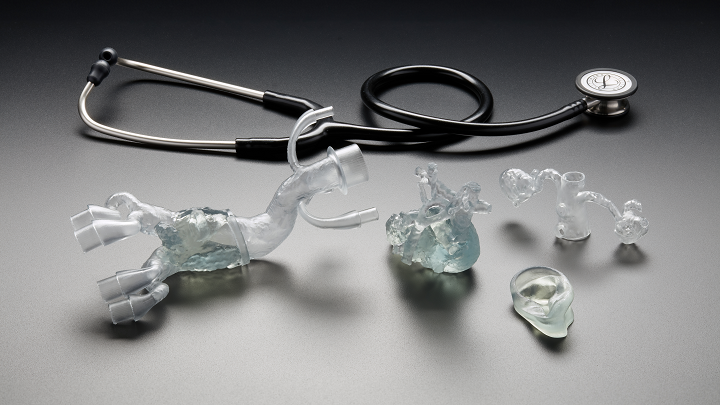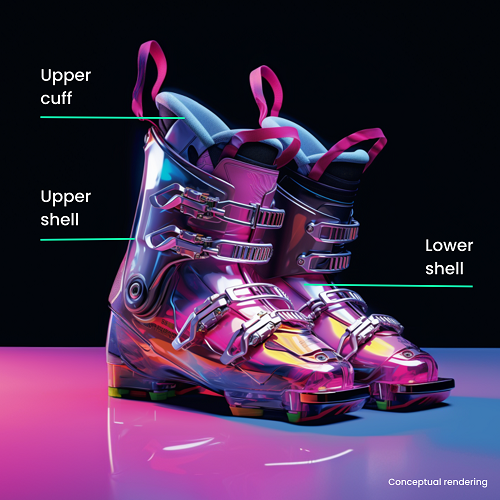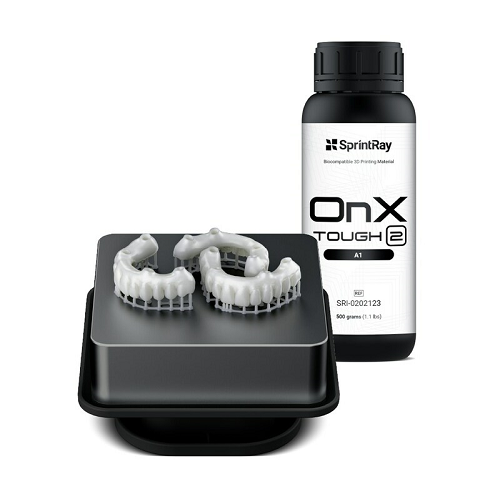We’re kicking off 3D Printing News Briefs with a little business today, as Horizon Microtechnologies invested in a micro AM platform from Boston Micro Fabrication, and Rivelin Robotics announced a partnership with Solukon, which also announced key upgrades for its SFM-AT350. Then it’s on to materials, as 3D Systems expanded its jewelry pattern manufacturing with a new 3D printer and new material, and Formlabs, Chromatic, and SprintRay all have new materials.
Horizon Microtechnologies Invests in Micro AM from BMF
Thanks to early stage financing recently secured by Horizon Microtechnologies, the company, which supplies in-house coating processes that add functionality and material to a microstructure, has invested in a micro AM platform from Boston Micro Fabrication (BMF), allowing it to offer a vertically integrated 3D microfabrication service. This allows Horizon to eliminate dependency on external vendors, reduce bottlenecks, and minimize lead times. BMF’s microArch S240 machine, from its 10μm series, features a large build volume, and prints intricate parts with high tolerance attainment and precision out of engineering-grade materials for industrial production applications. Horizon has already installed the microArch S240 at its facilities, enabling the company to print micro AM templates, and then apply its proprietary environmentally resistant, metallic, or non-metallic conductive coatings, in-house.
“The arrival of the BMF micro-AM machine is a vital step for us as a company. We already provide a suite of post-build coating technologies for micro AM parts to enhance their functionality, but our core know-how goes beyond this, with a unique in-house understanding of overall micro-AM based 3D microfabrication process chains. The introduction of the BMF micro-AM machine at our facilities brings the full technology infrastructure for leveraging this 3D microfabrication know-how on behalf of our customers in-house, which will create the enormous advantage for them of accessing a truly vertically integrated solution partner that can support from design through manufacturing to delivery in a one-stop-shop fashion. It will also speed up R&D and the innovation of our disruptive 3D capable post-build coating technologies for micro-AM parts, allow for a much broader and more agile and timely interaction with customers, and enhancing sales and marketing activities,” said Andreas Frölich, CEO at Horizon Microtechnologies.
Rivelin Robotics Partners with Solukon for Post-Processing
Rivelin Robotics and Solukon have been working together to drive automated solutions for post-processing metal and metal AM applications, and the results of their joint R&D project were on display at the recent formnext 2023. The two wanted to answer specific challenges their customers had reported, such as the need for localized and targeted vibration for depowdering large parts, robotic compressed air blasting, and robotic sensing solutions to inspect the air flow in cleared channels, among others. The companies identified areas where they could combine their areas of expertise, and worked to develop autonomous powder removal and finishing solutions. Their resulting system uses Rivelin’s Yaskawa EU robotic solutions and Netshape software, and Solukon’s SFM-AT800-S automated powder removal.
“One trend that is emerging in additive manufacturing is that the internal channels and cavities of parts are getting even more complex. Our aerospace customers in particular have exceptionally high requirements and often work with sticky behaviour materials like copper that require advanced automated depowdering,” said Andreas Hartmann, CEO / CTO at Solukon Maschinenbau. “With programmable rotation, targeted vibration and thanks to our SPR-Pathfinder® software without any human programming efforts, we also get the aerospace parts powder-free with our Solukon technology in a reliable and repeatable way. A very useful task for an integrated robot in our SFM-AT800-S is a channel cleanliness check with blowing or the removal of powder deposits from the surface of the components. We are very glad to have found this experienced partner for automated finishing in Rivelin.”
Solukon Launches Key Upgrades for SFM-AT350
Speaking of Solukon, the company made three important upgrades to its SFM-AT350 depowdering system, which has developed into a bestseller for medium-sized parts since its 2021 launch. The SFM-AT350 is now even stronger, smarter, and more efficient, to match the growing need for depowderinng increasingly complex parts. First, you can now quickly and easily calculate cleaning sequences for the machine with SPR-Pathfinder software, now available to remove excess powder from interior structures for the mid-range segment. Second, Solukon also upgraded its form of excitation, and now offers the SFM-AT350-E with piezoelectric excitation; the SFM-AT350 still has the typical pneumatic form in conjunction with a vibrator and an optional knocker. Finally, both are available with an enhanced Digital-Factory-Tool (DFT), featuring new tracking options. All of the upgrades, along with the new SFM-PCU powder collection unit with an SFM-AT1000-S, were exhibited at formnext 2023.
“The requirements for depowdering increase as part complexity, material complexity and diversity increase. Growing production quantities are also an influential factor. At the same time, our customers want us to provide systems that are very easy to operate,” Hartmann explained. “After experiencing a breakthrough with the launch of our smart SPR-Pathfinder® software, which calculates optimal part motion, we have achieved a further milestone upon launching the SFM-AT350-E: For any depowdering challenge, we can now offer the optimal frequency excitation.”
3D Systems Expands Jewelry Pattern Portfolio with New Printer & Material

VisiJet Wax Jewel Ruby is a medium softness wax that offers the optimal combination of material flexibility properties and dimensional stability in high-temperature or humid environments. Delivers improved capability for the presetting of stones.
3D Systems has made two additions to its portfolio of end-to-end solutions jewelry pattern manufacturing with the new MJP 300W 3D printer and VisiJet Wax Jewel Ruby material, both set to be available this month. First, the MJP 300W is the most flexible and advanced of the company’s wax printers, featuring enhanced quality, efficiency, design freedom, and productivity. It has two new print modes—QHD enables over 50% improved resolution in all axes and 9.5 µm layer thickness, while UHD mode can achieve 2x faster print speed than XHD mode on the ProJet MJP 2500W Plus, as well as increased throughput and decreased labor for finishing and polishing. The tough VisiJet Wax Jewel Ruby material is a temperature-stable pure wax, able to maintain fine feature details found in intricate jewelry patterns. It also offers flexible material properties and good dimensional stability, and patterns created with this material have shown durability, so they resist breaking during normal handling.
“One of the greatest benefits of additive manufacturing is providing unlimited design freedom, which is especially important to unleash the creativity required by skilled artisans. With the introduction of the MJP 300W and our new VisiJet Wax Jewel Ruby material, we are providing producers of wax jewelry casting patterns with enhanced capabilities to improve productivity and processes that ensure reliability,” said Marty Johnson, Vice President, Product & Technical Fellow, 3D Systems. “3D Systems’ full system integration of the materials, printer, print process, and software which is strengthened by our application expertise and global customer success team is enabling our jewelry manufacturing customers to achieve new levels of innovation, quality, and reliability. The latest additions to our end-to-end solutions for jewelry manufacturing reinforce our commitment to addressing our customers’ needs to gain unprecedented levels of agility with ease of use that ensures high-quality results at any scale.”
Formlabs Introduces Flexible BioMed and Dental Resins
Formlabs has added three new materials for healthcare applications to its portfolio, starting with the biocompatible BioMed Elastic 50A and BioMed Flex 80A resins. They both have ISO 10993 and USP Class VI certifications, and are suited for long-term skin contact and short-term mucosal membrane contact, making them perfect for comfortable medical devices, flexible patient-matched medical device components, molding, tissue medical models for use in the operating room, and more. BioMed Elastic 50A is soft and elastic, while BioMed Flex 80A is firm and flexible, and its ability to be directly printed should help decrease workflow times by getting rid of molding. The new IBT Flex resin, also biocompatible, is Class I FDA registered, and designed with translucent and tear-resistant properties for dental and orthodontic applications, like indirect bonding trays and direct composite restoration guides. All three are now available for the Form 3B/+ and Form 3BL 3D printers.
“Adoption of 3D printing is accelerating in healthcare and dentistry, bringing patients the benefit of personalized care that improves comfort and outcomes. Formlabs’ materials development team is dedicated to delivering new materials and solutions that will advance 3D printing in healthcare and dental workflows and expand the possibilities for patient-specific care,” said Guillaume Bailliard, Formlabs President of Healthcare. “By adding these new flexible and elastomeric materials to our extensive biocompatible and dental materials library, we are ushering in a new wave of personalized healthcare and digital dentistry that will bring the benefits directly to patients.”
Chromatic 3D Materials Launches Rigid ChromaMotive D65
3D printing technology company Chromatic 3D Materials has expanded into 3D printable rigid materials with its new ChromaMotive D65, great for winter sports gear like ski boots, snowshoes and snowmobile parts, as well as applications with varying temperature requirements, like automotive, agricultural, and aerospace. This is a Shore D thermoset polyurethane, designed for Reactive Extrusion Additive Manufacturing with the company’s RX-AM platform, and is compatible with the company’s RX-Flow printers. Parts made with this material perform well in a range of temperatures, from extreme cold (-30˚C) to extreme heat (120˚C), and feature mechanical performance properties comparable to injection molded PP, TPU, and HDPE. The new ChromaMotive D65 material withstands repeated friction and resists abrasion, high impact, and hydrolysis, and its isotropic tensile properties allow 3D printed parts to be uniformly resilient.
“With ChromaMotive™ D65, manufacturers that are producing rigid plastic components can take advantage of RX-AM’s fast print speeds and the ability to print on textiles, plastics, and metals,” said Dr. Cora Leibig, Founder and CEO of Chromatic 3D Materials. “Now it’s possible to 3D print rigid parts at industrial volumes for everything from winter recreational equipment to aircraft interiors.”
SprintRay Launches OnX Tough 2 3D Printing Resin
Finally, digital dentistry and 3D printed dental solutions provider SprintRay Inc. announced the launch of OnX Tough 2, which it says is the first and only 3D printing resin to receive FDA 510(k) clearance for fixed, implant-supported denture prosthetics. It was formulated using proprietary NanoFusion technology, which suspends the optimal amount of ceramic and thus reduces mixing. The process improves structural integrity, which then makes dental restorations 3D printed with the resin very tough, and well-suited for applications like implant-supported dentures. OnX Tough 2 is based on the chemistry from the original OnX Tough, but made with new pigments for better optical performance. It’s available in shades Bleach, A1, and A2, so 3D printed dentures feature improved color stability and precise shade matching, and they also also optimal radiopacity for treatment planning and imaging diagnostics. Using OnX Tough 2 and the SprintRay ecosystem, dental professionals are said to be able to print up to 10 fixed dentures in 30 minutes.
“Traditional processes for fixed, implant-supported dentures involve up to 6 patient visits and extensive fabrication time. We were convinced there had to be a chairside approach,” said SprintRay CEO and Co-Founder Amir Mansouri, Ph.D. “This achievement, marked by the first-ever FDA clearance for a 3D printing material for fixed hybrid dentures, ushers in a new era of same-day restorations while upholding the highest clinical standards, allowing patients to enjoy the benefits of their new smile immediately.”
Subscribe to Our Email Newsletter
Stay up-to-date on all the latest news from the 3D printing industry and receive information and offers from third party vendors.
You May Also Like
Further Understanding of 3D Printing Design at ADDITIV Design World
ADDITIV is back once again! This time, the virtual platform for additive manufacturing will be holding the first-ever edition of ADDITIV Design World on May 23rd from 9:00 AM –...
3D Printer Maker EVO-tech Reborn as NEVO3D — Once More With Feeling
EVO-tech was a 3D printing service and original equipment manufacturer established in 2013 and based in Schörfling am Attersee, Austria. The company produced high-quality material extrusion systems featuring linear bearings,...
3D Systems Brings 3D Printed PEEK Cranial Implant to the U.S. with FDA Clearance
For more than 10 years, 3D Systems (NYSE:DDD) has worked hand-in-hand with surgeons to plan over 150,000 patient-specific cases, and develop more than two million instruments and implants from its...
CDFAM Returns to Berlin for Second Annual Symposium
The second CDFAM Computational Design Symposium is scheduled for May 7-8, 2024, in Berlin, and will convene leading experts in computational design across all scales. Building upon the first event...





































